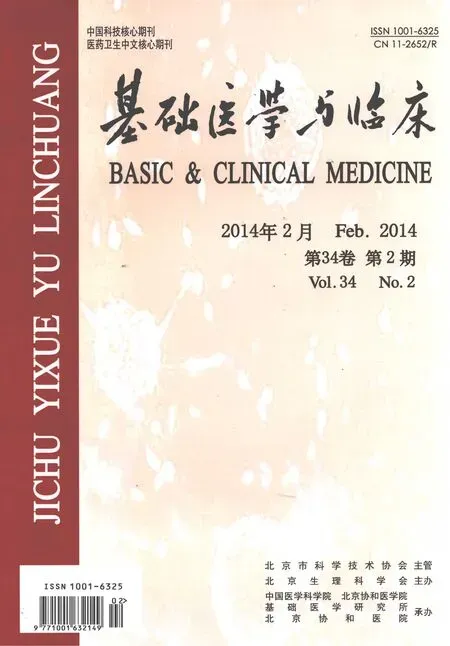动脉粥样硬化中炎性反应与内质网应激的相互作用
2014-04-15严经纬范亮亮
项 荣,严经纬,范亮亮,黄 皓,夏 昆*
(中南大学1.生命科学学院细胞生物学系,湖南长沙410013;2.医学遗传学国家重点实验室,湖南长沙410078)
炎性反应是动脉粥样硬化(Atherosclerosis,AS)的重要特征之一,炎性反应释放的多种生物活性因子,如 P38、核转录因子-κB(nuclear factor-κB,NF-κB)和肿瘤坏死因子-α(tumor necrosis factor-α,TNF-α)等,它们能通过损伤细胞功能、影响细胞迁移等参与 AS 病变过程[1-2]。
内质网应激(endoplasmic reticulum stress,ERS)是AS中的另一重要事件。各种AS相关的危险因素能改变内质网压力感受蛋白肌醇需要酶 1(inositol requiring enzyme 1,IRE1)、蛋白激酶受体样内质网激酶(protein kinase receptorlike ER kinase,PERK)和激活转录因子6(activating transcription factor 6,ATF6)等的表达及活性,诱发产生ERS。过长或过强的ERS,可激活c-Jun氨基末端激酶(C-Jun N-terminal kinase,JNK)和 C/EBP同源蛋白(C/EBP homologous protein,CHOP)为标志蛋白的促细胞凋亡信号途径。此外,ERS可参与内皮功能损伤,调控平滑肌增殖和凋亡,影响单核细胞分化和巨噬细胞泡沫化,进而影响 AS 斑块的形成[3-5]。
在AS中炎性反应和ERS并不是孤立存在的,它们之间存在着相互作用。一些调节炎性反应信号通路的生物活性分子,如NF-κB等,参与了ERS信号传导途径。最近的动物实验表明,使用NF-κB的多肽抑制剂不仅可以有效地降低前炎性因子的基因表达,还可以减少细胞迁移和细胞内的氧化应激等[6]。以下将对AS发生发展过程中不同细胞中的炎性反应与ERS的相互作用研究进展进行详细阐述。
1 内皮细胞的炎性反应与内质网应激
血管内皮细胞受损和功能减退是AS发生的始动环节,其中炎性反应与ERS相互影响、相互作用。氧化脂质能使内皮细胞轻度受损,这时氧化低密度脂类物质更易通过内皮屏障,并于内膜下沉积,而诱发局部炎性反应,释放炎性反应相关因子白细胞介素-1(interleukin-1,IL-1)、白细胞介素-6(interleukin-6,IL-6)和白细胞介素-12(interleukin-1,IL-12)等。它们的激活,能够促单核细胞募集、迁移,并且还能激活下游细胞黏附分子和炎性反应分子的表达等,参与 AS的病理进程[7-8];同时炎性反应细胞释放黏附分子,如血管细胞黏附分子-1(vascular cell adhesion molecule 1,VCAM-1)和细胞间黏附分子-1(intercellular adhesion molecule-1,ICAM-1),能诱导包括单核细胞和淋巴细胞等向血管炎性反应部位迁移、黏附、聚集并穿越血管壁,促进 AS斑块的形成[9]。
氧化脂质除引发炎性反应损伤内皮细胞外,还能增加活性氧族(reactive oxygen species,ROS)的增多,肌质网钙ATP酶(the sarco-endoplasmic reticulum Ca2+-ATPase,SERCA)的氧化增强而功能减弱,引起内质网的Ca2+逐渐耗竭;钙稳态的失衡进而引起NADPH氧化酶功能失常,最终引发ERS。因此,内皮细胞可以被诱导产生ERS,加剧内皮细胞功能障碍。
AS危险因素可诱发ERS,也介导多种炎性因子IL-6、白细胞介素-8(interleukin-8,IL-8)和单核细胞趋化蛋白-1(monocyte chemoattractant protein 1,MCP-1)等的表达[10-11]。而 ERS 中关键因子,如ATF4和X盒结合蛋白-1(X-box-binding protein 1,XBP-1)能明显抑制多种炎性因子的表达[10-11],即ERS可能通过抑制炎性反应的发生,在内皮细胞功能损伤初期,对AS起保护作用。而当ERS调控蛋白IRE1大量表达,能诱导并激活NF-κB和活化JNK,促进炎性分子TNF-α的表达,进而加剧黏附分子VCAM-1和ICAM-1在细胞内积累[12],表明在内皮损伤后期ERS加剧内皮细胞的炎性反应,促进AS的形成和发展。
2 平滑肌细胞的炎性反应与内质网应激
平滑肌细胞增殖和凋亡的紊乱是AS病变发展过程中的重要环节。受相邻受损内皮细胞的影响,炎性因子IL-1可作为一种有丝分裂原,通过NF-κB依赖的信号传导,促进平滑肌细胞大量增殖并迁移,并诱发下游的免疫炎性反应。而ERS也可以通过调控P38/促分裂素原活化蛋白激酶 (mitogen-activated protein kinases,MAPK)和 CHOP,影响平滑肌细胞的凋亡及活性。
在AS发展过程中,平滑肌细胞的炎性反应可调控ERS信号分子的表达。当平滑肌细胞中多种炎性反应相关分子的表达被激活后,释放 IL-8、MCP-1、NF-κB 和 TNF-α 等炎性因子,影响周围细胞并促进下游 P38、MAPK和 JNK等因子的表达[13-15]。而P38/MAPK是一条重要的ERS信号传导途径,JNK是 ERS诱发凋亡通路的一个重要分支[16-17]。
ERS也可传递炎性反应信号,介导炎性因子的表达。它通过调节自身信号分子P38/MAPK、细胞外调节蛋白激酶(extracellular regulated protein kinases,ERK),调节炎性因子IL-6和IL-12所介导的下游细胞因子的表达[18-20]。ERS的凋亡蛋白JNK对调节基质金属蛋白酶的表达起着重要作用。
3 单核/巨噬细胞的炎性反应与内质网应激
在AS早期,炎性反应相关因子能诱导巨噬细胞吞噬脂蛋白、细胞碎片和死细胞等以减少其沉积,降低局部炎性反应,防止AS进一步恶化。而在AS后期,炎性因子TNF-α则能刺激清道夫受体大量表达,促使巨噬细胞大量吞噬氧化型低密度脂蛋白,形成泡沫细胞,降低AS斑块的稳定性。沉默ERS信号通路中XBP-1和CHOP的表达,可以减慢AS的病变进程,这说明ERS参与了单核/巨噬细胞的病变。
单核/巨噬细胞的炎性反应与ERS均可被Toll样受体(Toll-like receptors,TLRs)的信号传导途径所调控。巨噬细胞的Toll样受体主要有2种Toll样受体2(Toll-like receptor 2,TLR2)和 Toll样受体 4(Toll-like receptor 4,TLR4)。TLRs能与配体结合,促进细胞因子的合成与释放,还可调控炎性反应相关因子 NF-κB,激活下游的炎性分子,如 IL-6和TNF-α 等[21-23]。经由肿瘤坏死因子受体相关因子6(tumor necrosis factor receptor-associated factor 6,TRAF6)和非吞噬细胞氧化酶2(non-phagocytic cell oxidase 2,NOX2)的信号传递,TLRs能上调 ERS相关XBP-1的表达,激活ERS的下游反应[24]。此外,TLR2可通过 P38/MAPK途径,调控炎性因子如IL-6、IL-10 和 TNF-α 的表达[25]。这说明巨噬细胞中的炎性反应与ERS也可直接互相调节。
4 结语与展望
动脉粥样硬化的发生和发展涉及多种因素与机制,炎性反应与ERS是AS的重要病理特征,虽然不同细胞内的调控机制相似却不相同,但可以肯定它们之间存在着相互作用,拥有一些共同调控分子,如 NF-κB、TNF-α 和 XBP-1 等。近年来,针对共同调控分子的药物逐渐被证实确实能起到减缓疾病进程的作用,但缺乏对病灶部位的靶向性,而使得临床应用相对困难。
在不同细胞,在不同的阶段,众多的炎性因子和生物活性物质参与其生理病理过程,使炎性反应与ERS之间形成复杂的分子网络,影响AS疾病的进程。深入研究它们的共同调控机制和药物靶向定位,将能进一步地明确炎性反应与内质网应激的相互作用及其对动脉粥样硬化的影响,或能更好地控制这类疾病的发生和发展。
[1]Wei L,Liu Y,Kaneto H,et al.JNK regulates serotoninmediated proliferation and migration of pulmonary artery smooth muscle cells[J].Am JPhysiol Lung Cell Mol Physiol,2010,298:863 -869.
[2]Chen C,Khismatullin DB.Synergistic effect of histamine and TNF-αon monocyte adhesion to vascular endothelial cells[J].Inflammation,2013,36:309 -319.
[3]Khan MI,Pichna BA,Shi Y,et al.Evidence supporting a role for endoplasmic reticulum stress in the development of atherosclerosis in a hyperglycaemic mouse model[J].Antioxid Redox Signal,2009,11:2289 -2298.
[4]Kedi X,Ming Y,Yongping W,et al.Free cholesterol overloading induced smooth muscle cells death and activated both ER-and mitochondrial-dependent death pathway[J].Atherosclerosis,2009,207:123 -130.
[5]Niculescu LS,Sanda GM,Sima AV.HDL inhibit endoplasmic reticulum stress by stimulating apoE and CETP secretion from lipid-loaded macrophages[J].Biochem Biophys Res Commun,2013,434:173-178.
[6]Mallavia B,Recio C,Oguiza A,et al.Peptide Inhibitor of NF-κB Translocation Ameliorates Experimental Atherosclerosis[J].Am JPathol,2013,182:1910 -1921.
[7]Kamari Y,Shaish A,Shemesh S,et al.Reduced atherosclerosis and inflammatory cytokines in apolipoprotein-E-deficient mice lacking bone marrow-derived interleukin-1α[J]. Biochem Biophys Res Commun, 2011, 405:197-203.
[8]Haubner F,Leyh M,Ohmann E,et al.Effects of external radiation in a co-culture model of endothelial cells and adipose-derived stem cells[J].Radiat Oncol,2013,8:66.
[9]Fotis L,Agrogiannis G,Vlachos IS,et al.Intercellular adhesion molecule(ICAM)-1 and vascular cell adhesion molecule(VCAM)-1 at the early stages of atherosclerosis in a rat model[J].In Vivo,2012,26:243 -250.
[10]Gargalovic PS,Gharavi NM,Clark MJ,et al.The unfolded protein response is an important regulator of inflammatory genes in endothelial cells[J].Arterioscler Thromb Vasc Biol,2006,26:2490 -2496.
[11]Gargalovic PS,Imura M,Zhang B,et al.Identification of inflammatory gene modules based on variations of human endothelial cell responses to oxidized lipids[J].Proc Natl Acad Sci U SA,2006,103:12741-12746.
[12]Cicha I,Urschel K,Daniel WG,et al.Telmisartan prevents VCAM-1 induction and monocytic cell adhesion to endothelium exposed to non-uniform shear stress and TNF-α[J].Clin Hemorheol Microcirc,2011,48:65 -73.
[13]Zhang Z,Chu G,Wu HX,et al.IL-8 reduces VCAM-1 secretion of smooth muscle cells by increasing p-ERK expression when 3-D co-cultured with vascular endothelial cells[J].Clin Invest Med,2011,34:138 - 146.
[14] Orr AW,Hastings NE,Blackman BR,et al.Complex regulation and function of the inflammatory smooth muscle cell phenotype in atherosclerosis[J].J Vasc Res,2010,47:168-180.
[15] Karagiannis GS,Weile J,Bader GD,et al.Integrative pathway dissection of molecular mechanisms of moxLDL-induced vascular smooth muscle phenotype transformation[J].BMC Cardiovasc Disord,2013,13:4.doi:10.1186/1471-2261-13-4.
[16]Rasheed Z,Haqqi TM.Endoplasmic reticulum stress induces the expression of COX-2 through activation of eIF2α,p38-MAPK and NF-κB in advanced glycation end products stimulated human chondrocytes[J].Biochim Biophys Acta,2012,1823:2179-2189.
[17]Liu CM,Zheng GH,Ming QL,et al.Protective effect of quercetin on lead-induced oxidative stress and endoplasmic reticulum stress in rat liver via the IRE1/JNK and PI3K/Akt pathway[J].Free Radic Res,2013,47:192 -201.
[18]Tang H,Sun Y,Shi Z,et al.YKL-40 induces IL-8 expression from bronchial epithelium via MAPK(JNK and ERK)and NF-κB pathways,causing bronchial smooth muscle proliferation and migration[J].JImmunol,2013,190:438-446.
[19]Poudel B,Ki HH,Lee YM,et al.Induction of IL-12 production by the activation of discoidin domain receptor 2 via NF-κB and JNK pathway[J].Biochem Biophys Res Commun,2013,434:584-588.
[20]Shea-Donohue T,Notari L,Sun R,et al.Mechanisms of smooth muscle responses to inflammation[J].Neurogastroenterol Motil,2012,24:802 -811.
[21]Dou W,Zhang J,Sun A,et al.Protective effect of naringenin against experimental colitis via suppression of Tolllike receptor 4/NF-κB signalling[J].Br J Nutr,2013:1-10.
[22]Li P,Neubig RR,Zingarelli B,et al.Toll-like receptorinduced inflammatory cytokines are suppressed by gain of function or overexpression of Gα(i2)protein[J].Inflammation,2012,35:1611-1617.
[23]Jin M,Iwamoto T,Yamada K,et al.Effects of chondroitin sulfate and its oligosaccharides on toll-like receptormediated IL-6 secretion by macrophage-like J774.1 cells[J].Biosci Biotechnol Biochem,2011,75:1283-1289.
[24]Martinon F,Chen X,Lee AH,et al.TLR activation of the transcription factor XBP1 regulates innate immune responses in macrophages[J].Nat Immunol,2010,11:411-418.
[25]Zhu G,Ge X,Zhu J,et al.Impaired cytokine production and decreased TLR2-mediated signaling in mouse infant macrophages[J]. Fetal Pediatr Pathol,2012, 31:365-373.
